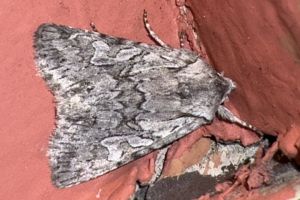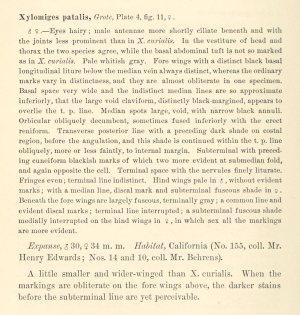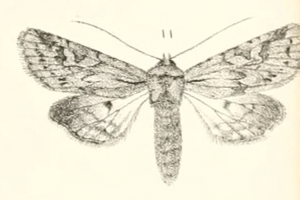

 +2Kontinente:EUNA
+2Kontinente:EUNA1. Lebendfotos
1.1. Falter
3. Biologie
3.1. Nahrung der Raupe
- [Rosaceae:] Rubus fruticosus agg. (Brombeere)
- [Rosaceae:] Rubus x loganobaccus (Loganbeere)
- [Rosaceae:] Rosa sp.
- [Pinaceae:] Pseudotsuga menziesii (Douglasie)
Rappaport (1988) berichtet in seinem Abstract: "Larvae of Lacinipolia patalis (Grote) (Lepidoptera: Noctuidae) were discovered in Douglas-fir (Pseudotsuga menziesii [Mirb.] Franco) cones collected from the Louisiana-Pacific Corporation's Little River Seed Orchard near Trinidad Head in Humboldt County, CA (elevation 91 m) during the fall of 1985. Previous surveys have not reported this noctuid from Douglas-fir cones (Keen 1958; Tietz 1972; Furniss and Carolin 1977; Hedlin et al. 1980; Ruth 1980; Schowalter et al. 1985). Its usual hosts are blackberry and loganberry (Rubus spp.) and roses (Rosa spp.); it normally feeds on foliage and, to some extent, dead fruit bases and dead leaves (Crumb 1956). The shift from angiosperm leaves and fruit to gymnosperm cones is somewhat surprising. Blackberries, however, grow around the perimeter of the seed orchard and along the rows between trees, and so provide an abundance of the usual host for L. patalis nearby." Rosaceen scheinen demnach doch die normale Raupennahrung zu sein.
(Autor: Erwin Rennwald)
4. Weitere Informationen
4.1. Andere Kombinationen
- Xylomiges patalis Grote, 1873 [Originalkombination]
- Xylomania patalis (Grote, 1873)
4.2. Faunistik
Locus typicus ist "California".
Lempke (1966: 191-192) berichtet über den überraschenden Fund eines Falters, den Sj. van der Molen im Jahr 1964 außen an einem Schaufenster in Arnhem gefunden hatte. Eine Erklärung, wie der Falter dorthin kam, konnte nicht gefunden werden.
(Autor: Erwin Rennwald)
4.3. Literatur
- Erstbeschreibung: Grote, A. R. (1873): Descriptions of Noctuidae principally from California. — Bulletin of the Buffalo Society of Natural Sciences 1: 129-155, pl. IV. [Digitalisat auf biodiversitylibrary.org]
- Kuchlein, J.H. & R. de Vos (1999): Geannoteerde Naamlijst van de Nederlandse Vlinders - Annotated Checklist of the Dutch Lepidoptera. — 302 S.; Leiden (Backhuys Publishers)
- Lempke, B.J. (1966): Xylomania patalis Grote in Nederland gevangen (Lep., Noctuidae). — Entomologische Berichten, Amsterdam, 26 (10): 191-192. [PDF-Download auf natuurtijdschriften.nl]
- Rappaport, N.G. (1988): Lacinipolia patalis Grote (Lepidoptera: Noctuidae) infesting Douglas-fir cones: a new host record. — Canadian Entomologist, 120 (11): 1033-1034. [Zugang zum Abstract und Bezahl-Download auf cambridge.org]






